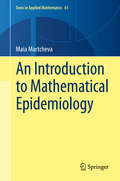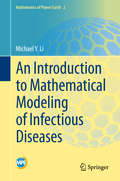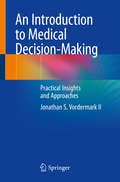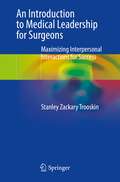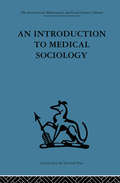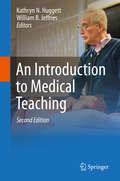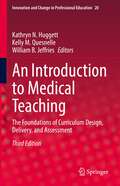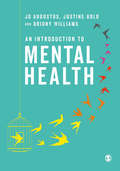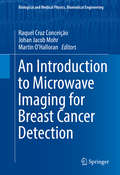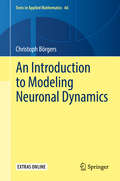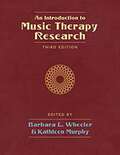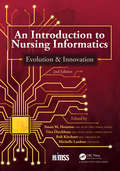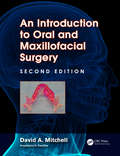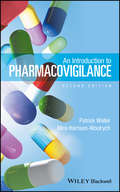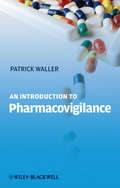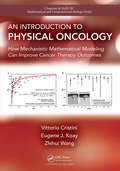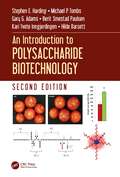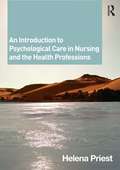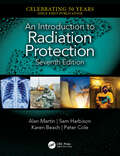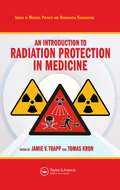- Table View
- List View
An Introduction to Mathematical Epidemiology (Texts in Applied Mathematics #61)
by Maia MartchevaThe book is a comprehensive, self-contained introduction to the mathematical modeling and analysis of infectious diseases. It includes model building, fitting to data, local and global analysis techniques. Various types of deterministic dynamical models are considered: ordinary differential equation models, delay-differential equation models, difference equation models, age-structured PDE models and diffusion models. It includes various techniques for the computation of the basic reproduction number as well as approaches to the epidemiological interpretation of the reproduction number. MATLAB code is included to facilitate the data fitting and the simulation with age-structured models.
An Introduction to Mathematical Modeling of Infectious Diseases (Mathematics of Planet Earth #2)
by Michael Y. LiThis text provides essential modeling skills and methodology for the study of infectious diseases through a one-semester modeling course or directed individual studies. The book includes mathematical descriptions of epidemiological concepts, and uses classic epidemic models to introduce different mathematical methods in model analysis. Matlab codes are also included for numerical implementations. It is primarily written for upper undergraduate and beginning graduate students in mathematical sciences who have an interest in mathematical modeling of infectious diseases. Although written in a rigorous mathematical manner, the style is not unfriendly to non-mathematicians.
An Introduction to Medical Decision-Making: Practical Insights and Approaches
by Jonathan S. Vordermark IIThis volume presents novel concepts to help physicians and health care providers better understand the thought processes and approaches used in clinical decision-making and how we develop those skills as we transition from being a medical student to post-graduate trainee to independent practitioner. Approaches presented range from simple rules of thumb, pattern recognition, and heuristics, to more formulaic methods such as standard operating procedures, checklists, evidence-based medicine, mathematical modeling, and statistics. Ways to recognize and manage errors and how our decision-making can be improved, are also discussed.An Introduction to Medical Decision-Making presents several innovative techniques to allow the reader to use the principles presented and integrate the ethical, humanistic and social aspects of decision-making with the pragmatic and knowledge-based aspects of clinical medicine. It also highlights how our thinking processes, emotions, and biases affect decision-making. This invaluable resource will allow students and physicians to evaluate and critically discuss their decisions objectively to become more efficient and effective, and maximize the quality of care they provide.
An Introduction to Medical Leadership for Surgeons: Maximizing Interpersonal Interactions for Success
by Stanley Zackary TrooskinHistorically, there has been a dearth of leadership instruction specifically designed for surgeons early in their careers, including the resident and junior attending levels, as well as for senior surgeons. Utilizing over 40 years of personal experience, this book focuses on applying the modern teaching tenets of medical leadership, illustrating them with the author's engaging stories as a surgeon, medical director and department chair - both what did and what did not work. Chapters are targeted for the specific issues related to the various stages of a surgical career, with the focus on maximizing successful personal interactions with peers, staff, and superiors. Consistently highlighting the benefits of emotional intelligence, as well as skills in managing up, down and sideways, the topics addressed include basic principles of medical leadership, clinical team leading for residents, operative leadership for new surgeons, successful committee participation, medical school leadership, and both elected and administrative hospital leadership. Selected chapters conclude with "Lessons Learned" - concise summaries of the key points of each chapter for easy reference.Written in both a personal and professional voice, An Introduction to Medical Leadership for Surgeons is an excellent resource for surgeons looking to lead at all levels of their career.
An Introduction to Medical Sociology (Social Science Paperbacks Ser.)
by David TuckettTavistock Press was established as a co-operative venture between the Tavistock Institute and Routledge & Kegan Paul (RKP) in the 1950s to produce a series of major contributions across the social sciences. This volume is part of a 2001 reissue of a selection of those important works which have since gone out of print, or are difficult to locate. Published by Routledge, 112 volumes in total are being brought together under the name The International Behavioural and Social Sciences Library: Classics from the Tavistock Press. Reproduced here in facsimile, this volume was originally published in 1976 and is available individually. The collection is also available in a number of themed mini-sets of between 5 and 13 volumes, or as a complete collection.
An Introduction to Medical Teaching
by William B. Jeffries Kathryn N. HuggettFew faculty members in academic medical centers are formally prepared for their roles as teachers. This work is an introductory text designed to provide medical teachers with the core concepts of effective teaching practice and information about innovations for curriculum design, delivery and assessment. It offers brief, focused chapters with content that is assimilated easily by the reader. The topics are relevant to basic science and clinical teachers and the work does not presume readers possess prerequisite knowledge of education theory or instructional design. The authors emphasize the application of concepts to teaching practice. Topics include: Facilitating Student Learning; Teaching Large Groups; Teaching in Small Groups; Flipping the Classroom; Problem-Based Learning; Team-Based Learning; Teaching Clinical Skills; Teaching with Simulation; Teaching with Practicals and Labs; Teaching with Technological Tools; Teaching to Develop Scientific Engagement in Medical Students; Designing a Course; Establishing and Teaching Elective Courses; Designing Global Health Experiences; Assessing Student Performance; Documenting the Trajectory of Your Teaching and Teaching as Scholarship. This is a complete revision of the first edition of this work with new chapters and up to date information. Similar to the first edition, chapters were written by leaders in medical education and research who draw upon extensive professional experience and the literature on best practices in education. Although designed for teachers, the work reflects a learner-centered perspective and emphasizes outcomes for student learning. The book is accessible and visually interesting and the work contains information that is current, but not time-sensitive. Each chapter concludes with references, many include recommendations for additional reading, and the work includes an appendix with resources for medical education.
An Introduction to Medical Teaching: The Foundations of Curriculum Design, Delivery, and Assessment (Innovation and Change in Professional Education #20)
by William B. Jeffries Kathryn N. Huggett Kelly M. QuesnelleThis is an introductory text designed to provide medical teachers with a comprehensive introduction to the core concepts of effective teaching practice. It contains introductory-level information about innovations for curriculum design, delivery, and assessment, all in a singular text. The work offers brief, focused chapters with content that can be easily assimilated by the reader. The topics are relevant to basic science and clinical teachers, and the work does not presume readers possess prerequisite knowledge of education theory or instructional design.The book builds upon and extends the content of the second edition by incorporating additional content to reflect advances in cognitive science and by updating existing chapters to keep pace with modern educational trends and technologies.
An Introduction to Mental Health
by Briony Williams Justine Bold Jo Augustus"A well-written resource providing up-to-date research and important examples of application to practice. Using a strong evidence-base, the book offers a variety of perspectives which speak to the challenges faced by managers, policy makers, patients, service users and carers." - Vanessa Evans, Foundation Degree in Mental Health Lead, Coleg Gwent An Introduction to Mental Health is essential reading for anyone learning the fundamentals of mental health. Written for an interdisciplinary audience with a patient-centred focus, it covers historical context through to contemporary issues, including mental health as it relates to the law and to policy. Key learning features include concept summaries, reflective points, case studies and reflective exercises to help situate content in the context of practice.
An Introduction to Mental Health
by Briony Williams Justine Bold Jo Augustus"A well-written resource providing up-to-date research and important examples of application to practice. Using a strong evidence-base, the book offers a variety of perspectives which speak to the challenges faced by managers, policy makers, patients, service users and carers." - Vanessa Evans, Foundation Degree in Mental Health Lead, Coleg Gwent An Introduction to Mental Health is essential reading for anyone learning the fundamentals of mental health. Written for an interdisciplinary audience with a patient-centred focus, it covers historical context through to contemporary issues, including mental health as it relates to the law and to policy. Key learning features include concept summaries, reflective points, case studies and reflective exercises to help situate content in the context of practice.
An Introduction to Microwave Imaging for Breast Cancer Detection (Biological and Medical Physics, Biomedical Engineering)
by Raquel Cruz Cruz Conceição Johan Jacob Jacob Mohr Martin O'HalloranThis book collates past and current research on one of the most promising emerging modalities for breast cancer detection. Readers will discover how, as a standalone technology or in conjunction with another modality, microwave imaging has the potential to provide reliable, safe and comfortable breast exams at low cost. Current breast imaging modalities include X- ray, Ultrasound, Magnetic Resonance Imaging, and Positron Emission Tomography. Each of these methods suffers from limitations, including poor sensitivity or specificity, high cost, patient discomfort, and exposure to potentially harmful ionising radiation. Microwave breast imaging is based on a contrast in the dielectric properties of breast tissue that exists at microwave frequencies. The book begins by considering the anatomy and dielectric properties of the breast, contrasting historical and recent studies. Next, radar-based breast imaging algorithms are discussed, encompassing both early-stage artefact removal, and data independent and adaptive beamforming algorithms. In a similar fashion, microwave tomographic reconstruction algorithms are reviewed in the following chapter, introducing the reader to both the fundamental and more advanced algorithms. Apart from imaging, the book also reviews research efforts in extracting clinically useful information from the Radar Target Signature of breast tumours, which is used to classify tumours as either benign or malignant. Finally, the book concludes by describing the current state of the art in terms of prototype microwave breast imaging systems, with a particular emphasis on those which have progressed to the clinical evaluation stage. This work is motivated by the fact that breast cancer is one of the leading causes of death amongst women in Europe and the US, and the second most common cancer in the world today. Such an important area of research will appeal to many scholars and practitioners. p>
An Introduction to Modeling Neuronal Dynamics
by Christoph BörgersThis book is intended as a text for a one-semester course on Mathematical and Computational Neuroscience for upper-level undergraduate and beginning graduate students of mathematics, the natural sciences, engineering, or computer science. An undergraduate introduction to differential equations is more than enough mathematical background. Only a slim, high school-level background in physics is assumed, and none in biology. Topics include models of individual nerve cells and their dynamics, models of networks of neurons coupled by synapses and gap junctions, origins and functions of population rhythms in neuronal networks, and models of synaptic plasticity.An extensive online collection of Matlab programs generating the figures accompanies the book.
An Introduction to Music Therapy Research
by Barbara L. WheelerAn introductory overview of how research has been conceived and implemented in music therapy over the last several decades. The book was designed for those who are beginning their studies in music therapy research, and it is especially well-suited for use as an accompaniment to classroom instruction. <P><P> Seventeen of the chapters were excerpted from Music Therapy Research (3rd Edition), a much larger volume of 68 chapters that gives considerable detail on numerous topics and sub-topics. In addition, three chapters (15, 16, 17) were specially written to provide a birds-eye view of some of the chapters that were not included, and in particular, those chapters in the larger book that examined the numerous methodological designs and approaches used in objectivist, interpretivist and other types of music therapy research.
An Introduction to Neuroendocrinology
by Richard E. Brown Michael Wilkinson Wilkinson, Michael and Brown, Richard E.How does the brain regulate sexual behavior, or control our body weight? How do we cope with stress? Addressing these questions and many more besides, this thoroughly revised new edition reflects the significant advances that have been made in the study of neuroendocrinology over the last twenty years. The text examines the importance of the hypothalamus in regulating hormone secretion from the endocrine glands, describing novel sites of hormone release including bone, heart, skeletal muscle and liver. The role of steroid hormone, neurotransmitter and peptide receptors, and the molecular responses of target tissues, is integrated into the discussion of the neuroendocrine brain, especially through changes in gene expression. Particular attention is attached to neuropeptides, including their profound influence on behavior. Complete with new full-color figures throughout, along with review and essay questions for each chapter, this is an ideal resource for undergraduate and graduate students of neuroscience, psychology, biology and physiology.
An Introduction to Nursing Informatics, Evolution, and Innovation, 2nd Edition: Evolution and Innovation (HIMSS Book Series)
by Susan M. Houston Tina Dieckhaus Bob Kircher Michelle LardnerNursing informatics (NI) is the specialty that integrates nursing science with information management and analytical sciences to identify, define, manage, and communicate data, information, knowledge, and wisdom in nursing practice. Nursing Informatics supports nurses, consumers, patients, the interprofessional healthcare team, and other stakeholders in a wide variety of roles and settings to achieve desired outcomes. This is accomplished through the use of information structures, information processes, and information technology. An Introduction to Nursing Informatics, Evolution and Innovation, 2nd Edition is the ideal gateway to all the professional possibilities this continuously evolving discipline has to offer. Describing the evolution of nursing informatics from its origins to current practice in today’s complex, diverse healthcare environment, this book offers the next generation of nurse informaticists an understanding of the discipline, best practices, and its scope of influence in healthcare. The book also explores Nursing Informatics as it is evolving into the future, including technology creation and implementation and the development of influential policies and best practices. Special features include descriptions of the ‘a day in the life’ from informatics nurses in multiple roles and fields of influence, including academia, research, clinical settings, the executive suite, consulting, and government, as well as an Appendix featuring case profiles. This new edition updates the content to better align with the current state of nursing informatics and expand on additional roles. New to this edition is a chapter providing tips and advice for those trying to find their first nursing informatics job or are changing their careers. Another new chapter covers healthcare analytics and how it fits into the nursing informatics role. An Introduction to Nursing Informatics, Evolution and Innovation, 2nd Edition is the ideal resource for nursing students and as a reference guide and pint of inspiration for nurses currently in the field.
An Introduction to Oral and Maxillofacial Surgery
by David MitchellHighly Commended, BMA Medical Book Awards 2015An Introduction to Oral and Maxillofacial Surgery encompasses the full range of oral and maxillofacial surgery. It also addresses the necessary core competencies for undergraduates and those pursuing basic specialist training. The second edition now includes international perspectives. In the UK, oral a
An Introduction to Performance Analysis of Sport (Routledge Studies in Sports Performance Analysis #6)
by Peter O'DonoghuePerformance analysis has become an essential tool for coaches, athletes, sports organisations and academic researchers. Collecting and interpreting performance data enables coaches to improve their training programmes, athletes to make better tactical decisions, sports organisations to manage teams more effectively, and researchers to develop a better understanding of sports performance. This book is an essential introduction to the fundamental principles of performance analysis of sport and how to develop and operate performance analysis systems. Containing worked examples from real sporting events throughout, the book introduces the basics of quantitative and qualitative performance analysis, reviews the different types of data and information that performance analysis can generate, and explains how to test for reliability. It presents a step-by-step guide to developing both manual and computerised analysis systems, and writing up and presenting findings from performance analysis programmes. Representing the most up-to-date, concise and engaging introduction to sports performance analysis, this book is an ideal course text for all introductory performance analysis courses, as well as an invaluable primer for coaches and practitioners in sport.
An Introduction to Pet Dental Care: For Veterinary Nurses and Technicians
by Kathy IstacePeriodontal disease is one of the most common diseases observed by small animal practitioners, and it is not uncommon for the veterinary technician to be the first line in oral health assessment and treatment. Despite this, current dentistry training for veterinary technicians and nurses is often very limited. This book explains the causes, consequences, prevention and treatment of pet dental diseases including periodontal disease, fractured teeth, tooth resorption, dental malocclusions, oral masses, jaw fractures, and other oral conditions. It covers: · Instruction in essential skills such as dental cleaning, charting, radiography, and equipment maintenance. · Advanced skills such as the administration of regional nerve blocks and periodontal treatments. · The aetiology and treatment of common oral conditions. Improving competence in veterinary dental skills benefits technicians, veterinary practices, owners and their pets. Explaining pet dental diseases in a relatable way, this book allows veterinary staff to relay important dental information to pet owners in a way they understand. Providing solutions to help prevent and manage pet dental diseases, it outlines treatment options, outcomes, and post-operative dental care.
An Introduction to Pharmacovigilance
by Patrick Waller Mira Harrison-WoolrychPharmacovigilance is the science and activities relating to the detection, assessment, understanding and prevention of adverse effects or any other drug-related problems. This introductory guide is designed to aid the rapid understanding of the key principles of pharmacovigilance. Packed full of examples illustrating drug safety issues it not only covers the processes involved, but the regulatory aspects and ethical and societal considerations of pharmacovigilance. Covering the basics step-by-step, this book is perfect for beginners and is essential reading for those new to drug safety departments and pharmaceutical medicine students. The second edition is thoroughly revised and updated throughout and includes a new chapter on clinical aspects of pharmacovigilance.
An Introduction to Pharmacovigilance
by Patrick WallerPharmacovigilance is the science and activities relating to the detection, assessment, understanding and prevention of adverse effects or any other drug-related problems. This introductory guide is designed to aid the rapid understanding of the key principles of pharmacovigilance. Packed full of examples illustrating drug safety issues it not only covers the processes involved, but the regulatory aspects and ethical and societal considerations of pharmacovigilance. Covering the basics step-by-step, this book is perfect for beginners and is essential reading for those new to drug safety departments and pharmaceutical medicine students.
An Introduction to Physical Oncology: How Mechanistic Mathematical Modeling Can Improve Cancer Therapy Outcomes (Chapman & Hall/CRC Mathematical Biology Series)
by Vittorio Cristini Eugene Koay Zhihui WangPhysical oncology has the potential to revolutionize cancer research and treatment. The fundamental rationale behind this approach is that physical processes, such as transport mechanisms for drug molecules within tissue and forces exchanged by cancer cells with tissue, may play an equally important role as biological processes in influencing progression and treatment outcome. <P><P>This book introduces the emerging field of physical oncology to a general audience, with a focus on recent breakthroughs that help in the design and discovery of more effective cancer treatments. It describes how novel mathematical models of physical transport processes incorporate patient tissue and imaging data routinely produced in the clinic to predict the efficacy of many cancer treatment approaches, including chemotherapy and radiation therapy. By helping to identify which therapies would be most beneficial for an individual patient, and quantifying their effects prior to actual implementation in the clinic, physical oncology allows doctors to design treatment regimens customized to each patient’s clinical needs, significantly altering the current clinical approach to cancer treatment and improving the outcomes for patients.
An Introduction to Polysaccharide Biotechnology
by Stephen E. Harding Michael P. Tombs Gary G. Adams Berit Smestad Paulsen Kari Tvete Inngjerdingen Hilde BarsettPolysaccharides and related high molecular weight glycans are hugely diverse with wide application in Biotechnology and great opportunities for further exploitation. An Introduction to Polysaccharide Biotechnology – a second edition of the popular original text by Tombs and Harding – introduces students, researchers, clinicians and industrialists to the properties of some of the key materials involved, how these are applied, some of the economic factors concerning their production and how they are characterized for regulatory purposes.
An Introduction to Psycho-Oncology
by Patrice GuexCancer is extremely common and in many situations a truly frightening disease, but for too long the psychological aspects and effects have been ignored. An Introduction to Psycho-Oncology deals in a clear and simple manner with the reactions of cancer patients to their illness, and the ways in which they can be helped. In the context of a multidisciplinary approach that takes account of medical treatments as well as psychological interventions, Guex offers suggestions for better ways of communicating so as to provide a therapeutic partnership between carer and client.
An Introduction to Psychological Care in Nursing and the Health Professions
by Helena PriestCaring is at the core of what nurses and other health professionals do. But caring encompasses more than simply looking after people’s physical health needs. People requiring any health service will have psychological needs that affect their feelings, thoughts, and behaviour. Good psychological care can even help improve physical health outcomes. An Introduction to Psychological Care in Nursing and the Health Professions explains and promotes the importance of psychological care for people when they become physically ill, giving a sound theoretical basis to ensure care is evidence-based. It encourages the reader to think about the effects of illness and disability on patients, and to understand what can be done to identify and minimise any difficulties they might be experiencing in these areas. The chapters cover: the meaning and elements of care and holistic care; a model of psychological care in practice; the personal qualities and skills of carers that best underpin psychological care delivery, and how these might be enhanced; the knowledge needed for effective psychological caregiving; psychological care as it might be practised in a range of health care settings. This text contains key learning points, practical activities, reflective exercises and case illustrations. It is ideal for student and practising nurses, and health professionals who would like to improve their care for patients in this essential area.
An Introduction to Radiation Protection
by Peter Cole Alan Martin Sam Harbison Karen BeachThis highly-readable account of the nature of the hazards presented by ionizing radiation and the methods of protection is an ideal introductory text for those new to the field, and for the non-specialist. The seventh edition continues to cover the technical principles underlying the control of radiation hazards, radiation detection and measurement and the biological effects of radiation, followed by a consideration of industry-specific radiation protection issues. Further specialised topics include risk assessment, waste management and decommissioning, radiological emergencies, relevant legislation and organizational issues and, new to this edition, environmental radiation protection.
An Introduction to Radiation Protection in Medicine (Series in Medical Physics and Biomedical Engineering)
by Jamie V. Trapp Tomas KronCombining facets of health physics with medicine, An Introduction to Radiation Protection in Medicine covers the background of the subject and the medical situations where radiation is the tool to diagnose or treat human disease. Encouraging newcomers to the field to properly and efficiently function in a versatile and evolving work setting,
